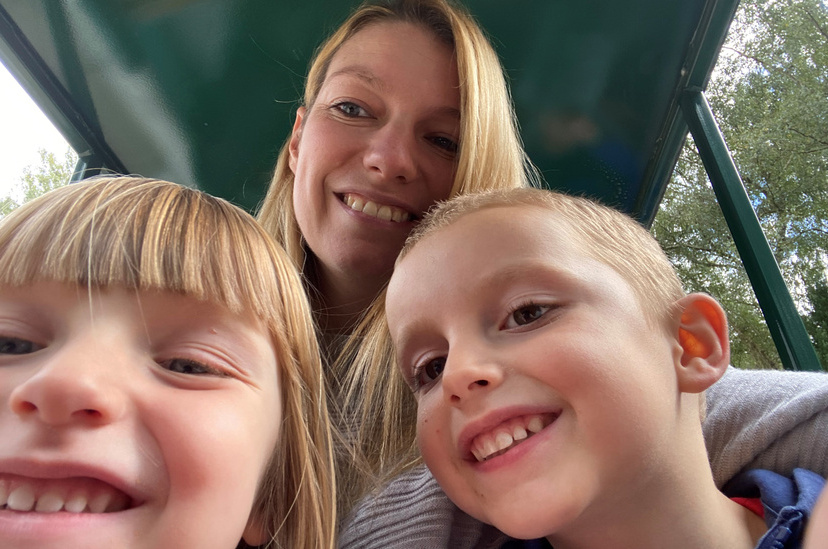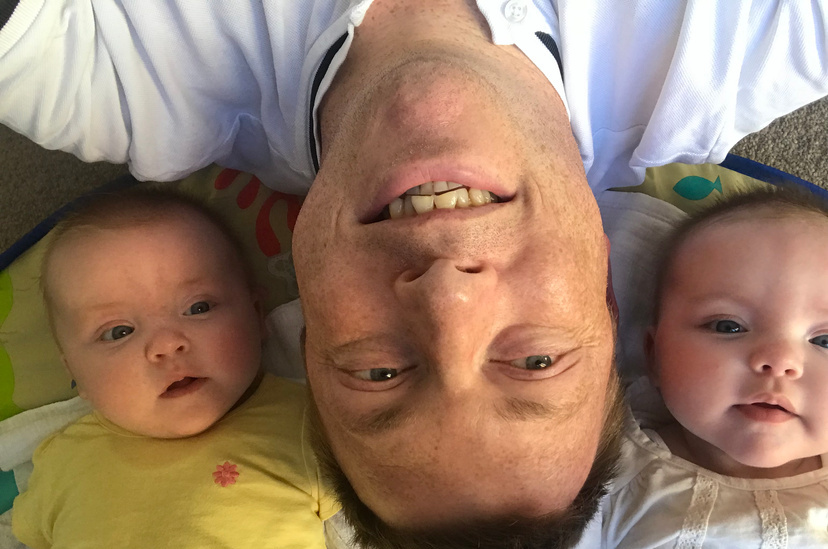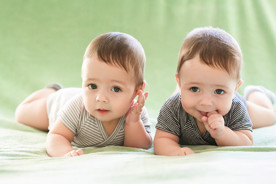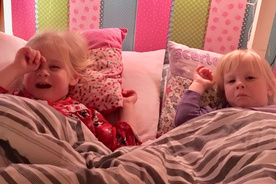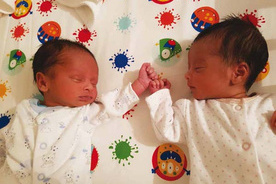If you have twins or triplets, it is possible for them to share a large sleep space - this is called co-bedding.
Research has shown that sleeping similar sized newborns within the same large cot does not mean that they wake more often - in fact, it can help with forming similar sleep patterns.
Generally, multiples who are used to co-bedding won't disturb each other, although every baby is different, so there will be exceptions.
You can safely put two or three babies in one cot by placing them in the feet-to-foot position, with bedding tucked in at the bottom and on both sides - and not loose (see the below diagrams for a visual explanation of this).
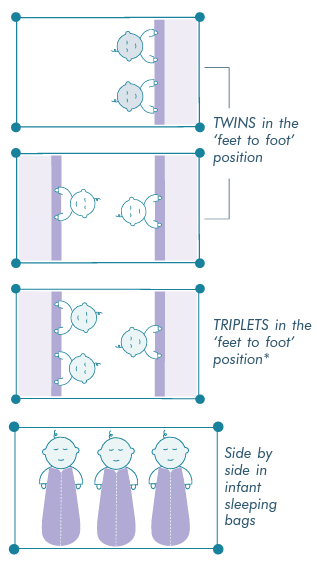
How to ensure safe sleep guidance is followed when co-bedding multiples
Here's a few things to avoid when co-bedding your multiples:
- Do not co-bed multiples in a small space, such as a moses basket or bassinet, due to the risk of overheating.
- Do not use rolled up blankets or towels to prop up your babies. You will often see premature babies in hospitals using props like this, but it's important to remember that in hospitals they are very closely monitored. When you bring them home, it's important to follow safe sleep practices unless advised by your medical professional.
- Do not co-bed your babies after they begin rolling or travelling around the cot - it's important that when they start moving, they have their own space to sleep.
Often, space is a big issue for families of twins, triplets and more - especially when the babies are unable to share a cot anymore. Many families do not have the space in their room or living area for two or more cots - we have tips to help you (below) whatever space you have in your house.
Commonly asked questions around space
Twins Trust has worked in conjunction with The Lullaby Trust to provide some answers to common questions around space:
Q: My babies are now four-months-old and they're too big to share a cot. I don't have space for two cots downstairs for daytime naps - what is the safest way to sleep them in the day?
- Placing your babies to sleep on their back for every sleep is essential to reducing the risk of SIDS. Travel cots, smaller cribs or cots or a combination may offer a good alternative for daytime naps downstairs until they are six months old.
- If this is not an option, leaving all of the doors open and checking on them regularly is important. Using a baby monitor may give some peace of mind, but it shouldn't replace your presence in the room whilst they're napping.
Q: I've read that babies need separate sleep spaces once they can roll and move about the cot. What is the best thing to do if I don't have space for two cots in my room?
- It can sometimes be difficult to follow the safer sleep advice if you are short of space. If you can’t fit two cots in your bedroom, make the advice work for you - leaving doors open between your rooms, or taking it in turns with your partner to sleep in with the twins in a nursery room can be good alternatives.
- If possible, it may be that you can borrow something smaller than a full-sized cot for a couple of months, such as a crib or a smaller travel cot.
- Think about whether you could move furniture around in your room, just for the months in which your babies would be sharing your room
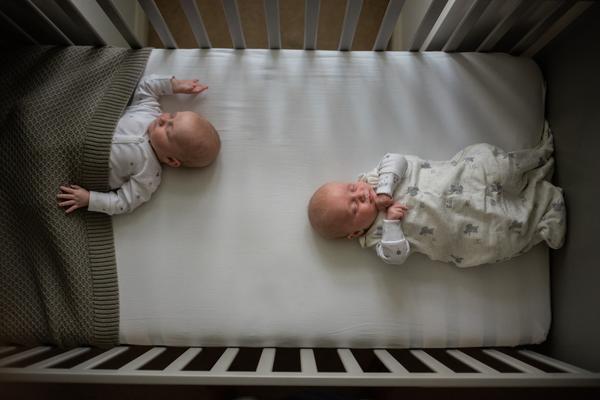
Can my twins and triplets share a next-to-me crib?
If you're consider using a next-to-me crib, please bear in mind all of our sleep guidance, particularly:
- Same Room for Six Months - it's recommended that the babies room-share with an adult for at least the first six months, where possible, to decrease the risk of SIDS.
- Separate Sleep Spaces - the crib should be big enough to allow each twin to have their own sleep space. They need adequate air flow around their face, so their faces should be well away from each other and any bedding. They should be able to move their heads freely to clear their airways.
- Bedding – use sleeping bags or ensure blankets are tucked in well to the foot and sides of the cot/crib.
- Adjacency - the greatest risk of a 'next to me'-style cot (aside from inadequate space) is that a baby falls into the gap between the cot and the bed. The crib should be securely attached to your bed to prevent any gaps where a baby could slip through.
- Separate them if rolling - when one of the babies starts rolling and/or moving around, they should then be put it their own separate sleep space to avoid rolling onto each other.
- Firm Mattress - use a firm mattress and fitted sheet specifically designed for the next to me crib. Again, this is to ensure that there are no potential loose objects which could cover baby’s face or interfere with airflow.
- Clear Space - ensure that there are no soft bedding, blankets, stuffed animals, or pillows in the crib that could obstruct the baby’s breathing or pose a suffocation hazard.
- No Overheating - dress the babies in light sleep clothing and maintain a comfortable room temperature (around 68–72°F or 20–22°C) to prevent overheating. Sleeping bags will often come with guides as to which tog to use in which temperature.
- Safe sleep position (see above).
- Regular assessments - regularly check on the babies to ensure they are in a safe position and their airways are clear. Even newborn babies can move their heads and sometimes bodies, so they might end up in a different position than you have placed them in. Also, periodically assess the crib setup for any potential hazards, such as loose parts or improper attachments.
- Make adjustments – babies grow and change constantly, as do their sleep requirements . Use the above guidelines to make adjustments as needed.
Explore more advice about sleep
Access further resources as a registered user
Personal stories from parents of multiples
Hear personal stories about how people have experienced sleep with their multiples and how Twins Trust services like our helpline supported them.
Further help and resources from Twins Trust
Sleep for twins, triplets and more is one of our most asked about topics and we understand that there are lots of questions you may have about how your babies are sleeping. We're here to support you during this stage of your children's development and the below resources have lots more useful information about sleep.
-strap.svg)
